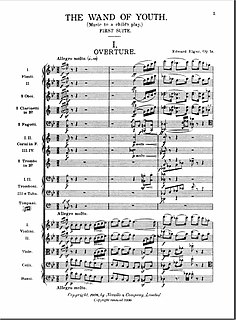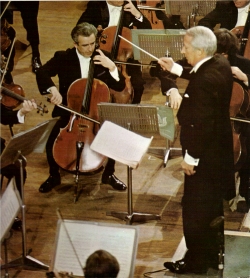Related Research Articles

Sir Edward William Elgar, 1st Baronet, was an English composer, many of whose works have entered the British and international classical concert repertoire. Among his best-known compositions are orchestral works including the Enigma Variations, the Pomp and Circumstance Marches, concertos for violin and cello, and two symphonies. He also composed choral works, including The Dream of Gerontius, chamber music and songs. He was appointed Master of the King's Musick in 1924.
The Pomp and Circumstance Marches, Op. 39, are a series of six marches for orchestra composed by Sir Edward Elgar. The first four were published between 1901 and 1907, when Elgar was in his forties; the fifth was published in 1930, a few years before his death; and the sixth, compiled posthumously from sketches, was published in 2005–2006. They include some of Elgar's best-known compositions.
Gordon Percival Septimus Jacob CBE was an English composer and teacher. He was a professor at the Royal College of Music in London from 1924 until his retirement in 1966, and published four books and many articles about music. As a composer he was prolific: the list of his works totals more than 700, mostly compositions of his own, but a substantial minority of orchestrations and arrangements of other composers' works. Those whose music he orchestrated range from William Byrd to Edward Elgar to Noël Coward.

Sir Edward Elgar's Symphony No. 2 in E♭ major, Op. 63, was completed on 28 February 1911 and was premiered at the London Musical Festival at the Queen's Hall by the Queen's Hall Orchestra on 24 May 1911 with the composer conducting. The work, which Elgar called "the passionate pilgrimage of the soul", was his last completed symphony; the composition of his Symphony No. 3, begun in 1933, was cut short by his death in 1934.
Herbert Whitton Sumsion CBE was an English musician who was organist of Gloucester Cathedral from 1928 to 1967. Through his leadership role with the Three Choirs Festival, Sumsion maintained close associations with major figures in England's 20th-century musical renaissance, including Edward Elgar, Herbert Howells, Gerald Finzi, and Ralph Vaughan Williams. Although Sumsion is known primarily as a cathedral musician, his professional career spanned more than 60 years and encompassed composing, conducting, performing, accompanying, and teaching. His compositions include works for choir and organ, as well as lesser-known chamber and orchestral works.
Symphony No. 4, Op. 29, FS 76, also known as "The Inextinguishable", was completed by Danish composer Carl Nielsen in 1916. Composed against the backdrop of the First World War, this symphony is among the most dramatic that Nielsen wrote, featuring a "battle" between two sets of timpani.

En saga, Op. 9, is a single-movement tone poem for orchestra written in 1891–92 by the Finnish composer Jean Sibelius. The piece, which likely began as a septet or octet for flute, clarinet, and string ensemble before evolving into an orchestral tone poem, premiered on 16 February 1893 in Helsinki, with Sibelius conducting the Helsinki Orchestral Society. A decade later in 1902, Sibelius substantially revised En saga in response to an invitation from Ferruccio Busoni to conduct the piece in Berlin; the tone poem thus stands alongside the Lemminkäinen Suite, the Violin Concerto, The Oceanides, and the Fifth Symphony as one of Sibelius' most overhauled works. The Berlin concert, which occurred a fortnight after Robert Kajanus had premiered the revised piece in Helsinki on 2 November, finally brought Sibelius the German breakthrough he had long desired.
Sinfonia da Requiem, Op. 20, for orchestra is a symphony written by Benjamin Britten in 1940 at the age of 26. It was one of several works commissioned from different composers by the Japanese government to mark Emperor Jimmu's 2600th anniversary of the founding of the Japanese Empire. The Japanese government rejected the Sinfonia for its use of Latin titles from the Catholic Requiem for its three movements and for its somber overall character, but it was received positively at its world premiere in New York under John Barbirolli. A performance in Boston under Serge Koussevitzky led to the commission of the opera Peter Grimes from the Koussevitzky Music Foundations.
In the South (Alassio), Op. 50, is a concert overture composed by Edward Elgar during a family holiday in Italy in the winter of 1903 to 1904. More than twenty minutes long, it may also be considered a "tone poem".
William Babell was an English musician, composer and prolific arranger of vocal music for harpsichord.

The Danish composer Carl Nielsen wrote his Symphony No. 3 "Sinfonia Espansiva", Op. 27, FS 60, between 1910 and 1911. Around 35 minutes in length, it is unique in his symphonic output for having vocal parts, specifically wordless solos for soprano and baritone in the second movement.

The Wand of Youth Suites No. 1 and No. 2 are works for full orchestra by the English composer Edward Elgar. The titles given them by Elgar were, in full: The Wand of Youth First Suite, Op. 1a (1869–1907) and The Wand of Youth Second Suite,.

Cockaigne , Op. 40, also known as the Cockaigne Overture, is a concert overture for full orchestra written by the British composer Edward Elgar in 1900–1901.
Froissart, Op. 19, is a concert overture by Edward Elgar, inspired by the 14th-century Chronicles of Jean Froissart. Elgar was first attracted to the Chronicles after finding mention of them in Walter Scott's Old Mortality.
Polonia is a symphonic prelude by the English composer Edward Elgar written in 1915 as his Op. 76.

Chanson de Matin, Op. 15, No. 2, is a musical work composed by Edward Elgar for violin and piano, and later orchestrated by the composer. Its first publication was in 1899, though it is thought that it was almost certainly written in 1889 or 1890.
Canto Popolare is an arrangement for viola with piano accompaniment, made by the English composer Edward Elgar. It is from the viola solo in the central section of his concert-overture In the South (Alassio), written in 1904.
The String Quartet in E minor, Op. 83, was one of three major chamber music works composed by Sir Edward Elgar in 1918. The others were the Violin Sonata in E minor, Op. 82, and the Piano Quintet in A minor, Op. 84. Along with the Cello Concerto in E minor, Op. 85 of 1919, these were to be his last major works prior to his death in 1934.
The Severn Suite, Opus 87, is a musical work written by Sir Edward Elgar. It is a late composition, written in 1930, the result of an invitation to write a test piece for the National Brass Band Championship. It was dedicated to his friend, the author and critic George Bernard Shaw.

The Concerti Grossi, Op. 3, HWV 312–317, are six concerti grossi by George Frideric Handel compiled into a set and published by John Walsh in 1734. Musicologists now agree that Handel had no initial knowledge of the publishing. Instead, Walsh, seeking to take advantage of the commercial success of Corelli's Opus 6 Concerti Grossi, simply combined several of Handel's already existing works and grouped them into six "concertos".
References
Citations
- ↑ Kennedy 1987, pp. 355–356.
- ↑ McVeagh 2007, p. 187: "Elgar ... conducted its first performance on 2 September 1923 ... he valued it enough to record it the next month."
- ↑ Reed 1989, p. 43.
- ↑ Moore 1984, p. 765: "[Elgar] wrote to Novello's music editor John E. West: 'I have known the overture ... since I was a little boy and always wanted it to be heard in a large form."
- ↑ Novello & Co., full score
Sources
- Kennedy, Michael (1987). Portrait of Elgar (Third ed.). Oxford: Oxford University Press. ISBN 0-19-284017-7.CS1 maint: ref=harv (link)
- McVeagh, Diana M. (2007). Elgar the Music Maker . Woodbridge, Suffolk: Boydell Press. ISBN 978-1-84383-295-9.CS1 maint: ref=harv (link)
- Moore, Jerrold N. (1984). Edward Elgar: A Creative Life. Oxford: Oxford University Press. ISBN 0-19-315447-1.CS1 maint: ref=harv (link)
- Reed, W. H. (1989) [First published 1936]. Elgar as I knew him (Second ed.). Oxford: Oxford University Press. ISBN 0-19-282257-8.CS1 maint: ref=harv (link)